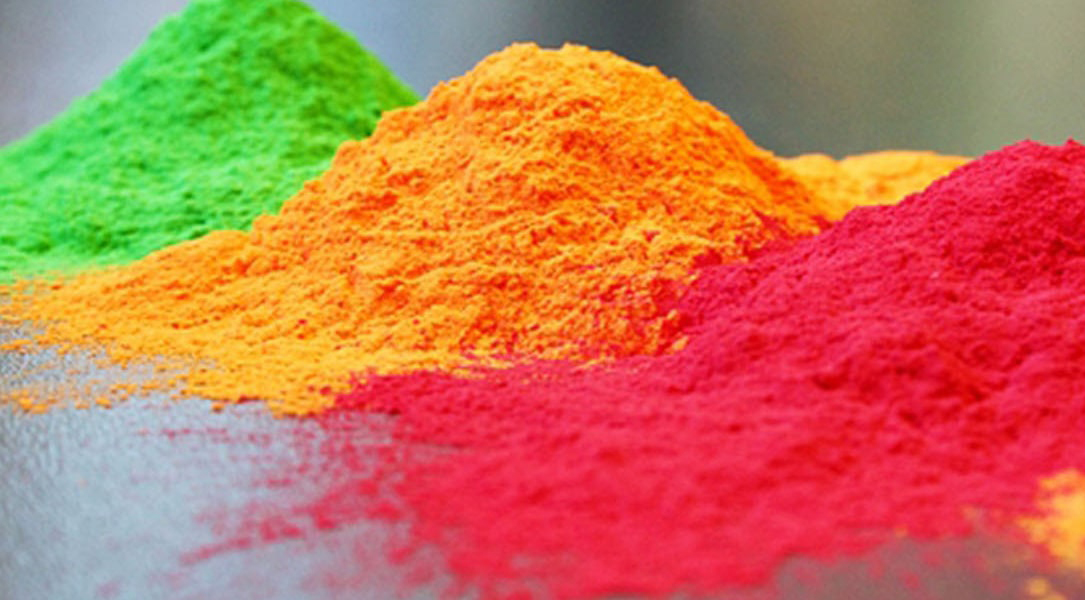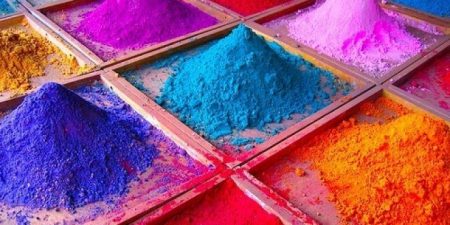What are industrial pigments? Which industrial pigments are used the most today?
Nowadays, the application of pigments is increasingly focused, especially the industries of paints, plastics, textiles, fertilizers ... The selection of good and suitable pigments will be an important part to decide the quality of the output of the business. So today we go together deeply to learn about this product, to pocket the experience when choosing.

Industrial Pigments concept:
Industrial pigments are chemical preparations, compressed into a powder from colorants. They have high dispersibility and insolubility in the dispersing medium, and are used by mixing with solutions such as paints, resins ... to color the product.
Currently, there are many types of industrial colors produced in different forms: powder, wax, water ... but the powder form is still preferred because it has many outstanding advantages such as:
- Ease of use: Because it is in powder form, when using it, it is only necessary to mix it with the coloring product without complicated preparation, no need for too deep expertise to perform this step.
- Easy to store and transport: Just store the pigments in plastic and glass containers, keep in a dry place, protected from light. The product is very difficult to contaminate impurities (not like wax or water).
- Low price: Among industrial colors, pigment has the cheapest price.

Classification: Industrial pigments have 2 main types as follows:
1. Organic pigments: powdery solid compounds that produce different colors. Including surname:
- Pigment azo (-N = N-): they are most used in the plastic industry due to its completely soluble properties in plastic. However, azo has the disadvantage of being easy to migrate, so it is often combined with metal ions or functional groups such as amide (-NHCO-) to increase its resistance to migration. Common colors: yellow, orange, red.
- Pigment phthalocyanine [-C6H4 (CN) 2)]: More commonly known as copper phthalocyanine (copper phthalocyanine). Some of the outstanding advantages of this form are: weatherproof, good heat resistance, standard mobility, standard acidity and alkalinity. Therefore, phthalocyanine pigment is also widely used in many industries. Common colors: blue, dark green.
- Pigment Antraquinon: The most prominent of this family is Alizarin (orange-red compounds, which are sparkling luminescent crystals). The Antraquinone family is widely used in the textile industry.
- Pigment dye: Because it is mobile, it is often used in plastics with glass transition temperatures higher than room temperature such as PS, PMMA, uPVC.
Advantages: Organic pigment is characterized by clear, fresh and high color fastness (stable temperature, alkali resistance, acid resistance ...)
Disadvantage: The cost is relatively high compared to inorganic pigment. In addition, it is susceptible to oxidation under light, easily affected by weather factors.
2. Inorganic pigments: are ferrous metals or insoluble metal salts. Includes: white (TiO2), black (carbon black), colored inorganic pigment ...
White titanium dioxide (TiO2). In the plastic industry, TiO2 is extremely widely used, and there are two types: hiding and non - hiding.
+ Non - hiding white powder: Has a low refractive index, so the ability to create poor opacity, used as a filler or filler, the price is relatively cheap. The commonly used non - hiding white substances are calcium carbonate, talc, clay and silica.
+ White powder hiding: Has a high refractive index, capable of creating opacity in plastic products. The most important ingredient is TiO2 because it has strong absorption of UV radiation so it has the advantage of creating high opacity and white color (maximum reflectance, minimum absorption), good aging resistance and non-toxicity. In addition, there are several other commercially hiding white pigment such as: Zinc oxide (ZnO), Zinc sulfite (ZnSO3), lithopone (mixture of ZnS and BaSO4), anthony oxide ...
- Black: The most prominent is Carbon black (charcoal black). It is the most important black pigment, used very popularly in the plastics industry (after TiO2). Carbon black has high color fastness, when combined with weather-resistant, heat-oxidizing UV absorbers, especially used on LDPE resin substrates. In addition, carbon black can contribute to improving the electrical conductivity or insulation of the polymer. In particular, the cost of this color is relatively low compared to the general ground.
- Colored inorganic pigments: There are the following types:
+ Iron oxide: is the most important color in the inorganic pigment system. There are colors from yellow, red to brown, black. This type is produced from natural or synthetic ores. These include: Red iron oxide (considered Fe2O3 in crystal form), yellow iron oxide [hydroxide oxide - FeO (OH)], brown iron oxide (mixture of FeO and Fe2O3).
The color of iron oxide is distinguished by its aging durability, opaque appearance, excellent UV resistance, and low cost. However, the intensity of the color and the freshness are poor so its use is limited.
+ Chromium oxide (Cr2O3): belongs to a single oxide color with dark green color, weak dyeing ability, aging resistance but not heat stability.
+ Mixed phase oxide: heat stable, weather resistant, color fastness and relative freshness. Some popular colors: cobalt aluminate blue, antimony titanium gold.
- Lead chromate powder: green - yellow to yellow - red color range. This powder gives a bright, weather-resistant color. Used mainly in paint industry.
- Ultramarrine Blue: A complex form of zeolytic sodium aluminosilicate, which is light and heat resistant, and slightly resistant to acids. Widely used, has a very bright reddish-green color in resin.
Advantages: Inorganic pigments are usually durable under light, weather, have high heat resistance, and are resistant to solvents ... The price is cheaper than organic.
Cons: the color is not as bright as organic pigment.

Some other industrial pigments:
In addition to the above organic and inorganic pigment, there are some special colors that can be mentioned as:
- Metallic colors: most importantly based on finely dispersed aluminum flakes, they are used concurrently with metallic colors or combined with organic pigment to create a new metallic effect.
- The iridescent color is usually pre-dispersed in the liquid plasticizer or the resinous resin because the dry aluminum flakes tend to explode. When dispersing iridescent colors into the polymer substrate, the shear force should be minimized to avoid fracture or scale deformation, which reduces color effects.
- Fluorescent color: a characteristic property is the ability to convert UV light into a visible color. This color has very vibrant shades thanks to a very high level of light reflection.
- Nacre color: the most important is the thin mica flakes coated with TiO2 which are partly reflective and partly transmitted through the incident light. Simultaneous reflection of multiple layers of orientation creates a characteristic mother-of-pearl color. When the grain thickness is suitable, color is produced by light interference. When mixed into plastic, the sliding speed must be suitable to avoid breaking the scale structure.

Note when choosing industrial pigments:
We have just learned an overview and detail about today's industrial pigments. The question is: How can I optimize my choice of this color? To be able to give the most plausible answer, we need to note the following:
- Choose according to your needs: Each powder has different applications. So the prerequisite is to know which color to use for which product, to avoid waste.
- Enough quantity: As a habit, customers will often buy in large quantities to have a reasonable price. However, this is easy to waste in the process of using.
- Supplier: There are many widespread industrial pigments in the market today. In order to be able to buy products that meet quality standards, it is essential to find a reputable supplier.
Sunrise Colors Vietnam with nearly 20 years of experience in the profession, we are proud to be a reputable manufacturer and distributor trusted by customers during the past time. With a technical team with in-depth knowledge of the product, we will advise you in the most optimal and reasonable way.
SUNRISE COLOURS VIETNAM CO., LTD
Add: CT2A Building, Gelexia Riverside Apartment, 885 Tam Trinh Street, Yen So Ward, Hoang Mai District, Hanoi City.
Phone: +84 986998350 Fax: 0084 02436452586
Moblie/What'sapp/Wechat: 84 986998350
Email: sales3@sunrisecolour.com
Website: http://sunrisecolour.com
Related posts


.png)








